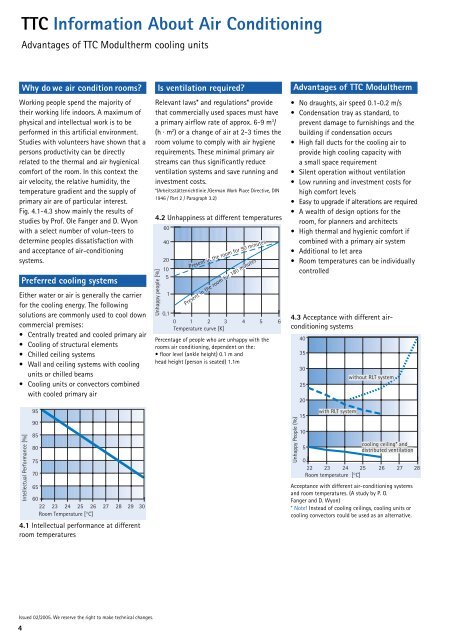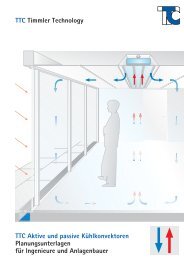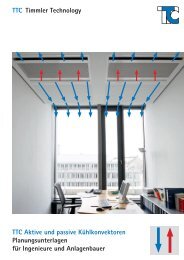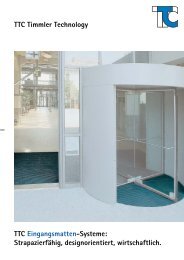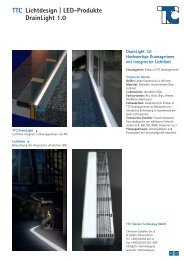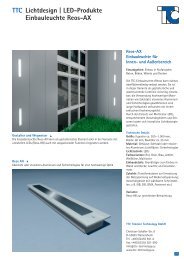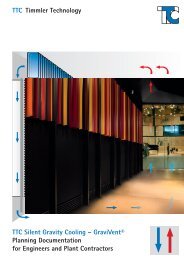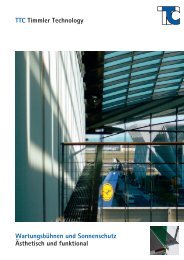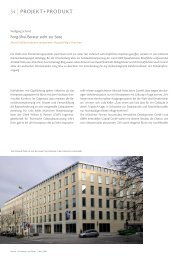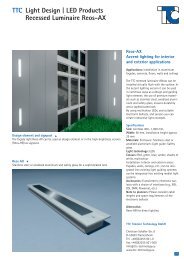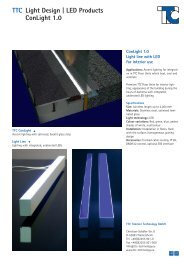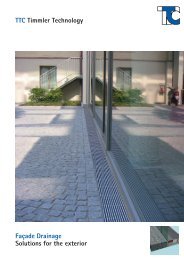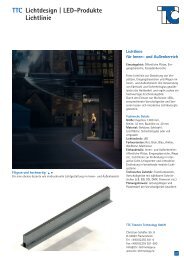TTC Timmler Technology TTC Silent Gravitiy Cooling – Modultherm ...
TTC Timmler Technology TTC Silent Gravitiy Cooling – Modultherm ...
TTC Timmler Technology TTC Silent Gravitiy Cooling – Modultherm ...
Create successful ePaper yourself
Turn your PDF publications into a flip-book with our unique Google optimized e-Paper software.
4<br />
<strong>TTC</strong> Information About Air Conditioning<br />
Advantages of <strong>TTC</strong> <strong>Modultherm</strong> cooling units<br />
Why do we air condition rooms? Is ventilation required?<br />
Advantages of <strong>TTC</strong> <strong>Modultherm</strong><br />
Working people spend the majority of<br />
their working life indoors. A maximum of<br />
physical and intellectual work is to be<br />
performed in this artificial environment.<br />
Studies with volunteers have shown that a<br />
persons productivity can be directly<br />
related to the thermal and air hygienical<br />
comfort of the room. In this context the<br />
air velocity, the relative humidity, the<br />
temperature gradient and the supply of<br />
primary air are of particular interest.<br />
Fig. 4.1-4.3 show mainly the results of<br />
studies by Prof. Ole Fanger and D. Wyon<br />
with a select number of volun-teers to<br />
determine peoples dissatisfaction with<br />
and acceptance of air-conditioning<br />
systems.<br />
Preferred cooling systems<br />
Either water or air is generally the carrier<br />
for the cooling energy. The following<br />
solutions are commonly used to cool down<br />
commercial premises:<br />
• Centrally treated and cooled primary air<br />
• <strong>Cooling</strong> of structural elements<br />
• Chilled ceiling systems<br />
• Wall and ceiling systems with cooling<br />
units or chilled beams<br />
• <strong>Cooling</strong> units or convectors combined<br />
with cooled primary air<br />
Intellectual Performance [%]<br />
95<br />
90<br />
85<br />
80<br />
75<br />
70<br />
65<br />
60<br />
22 23 24 25 26 27 28 29 30<br />
Room Temperature [°C]<br />
4.1 Intellectual performance at different<br />
room temperatures<br />
Issued 02/2005. We reserve the right to make technical changes.<br />
Relevant laws* and regulations* provide<br />
that commercially used spaces must have<br />
a primary airflow rate of approx. 6-9 m 3 /<br />
(h · m 2 ) or a change of air at 2-3 times the<br />
room volume to comply with air hygiene<br />
requirements. These minimal primary air<br />
streams can thus significantly reduce<br />
ventilation systems and save running and<br />
investment costs.<br />
*(Arbeitsstättenrichtlinie /German Work Place Directive, DIN<br />
1946 / Part 2 / Paragraph 3.2)<br />
4.2 Unhappiness at different temperatures<br />
Unhappy people [%]<br />
60<br />
40<br />
20<br />
10<br />
5<br />
1<br />
0,1<br />
Present in the room for 90 minutes<br />
Present in the room for 180 minutes<br />
0 1 2 3 4 5 6<br />
Temperature curve [K]<br />
Percentage of people who are unhappy with the<br />
rooms air conditioning, dependent on the:<br />
• floor level (ankle height) 0.1 m and<br />
head height (person is seated) 1.1m<br />
• No draughts, air speed 0.1-0.2 m/s<br />
• Condensation tray as standard, to<br />
prevent damage to furnishings and the<br />
building if condensation occurs<br />
• High fall ducts for the cooling air to<br />
provide high cooling capacity with<br />
a small space requirement<br />
• <strong>Silent</strong> operation without ventilation<br />
• Low running and investment costs for<br />
high comfort levels<br />
• Easy to upgrade if alterations are required<br />
• A wealth of design options for the<br />
room, for planners and architects<br />
• High thermal and hygienic comfort if<br />
combined with a primary air system<br />
• Additional to let area<br />
• Room temperatures can be individually<br />
controlled<br />
4.3 Acceptance with different airconditioning<br />
systems<br />
Unhappy People (%)<br />
40<br />
35<br />
30<br />
25<br />
20<br />
15<br />
10<br />
with RLT system<br />
without RLT system<br />
5<br />
0<br />
cooling ceiling* and<br />
distributed ventilation<br />
22 23 24 25 26 27 28<br />
Room temperature [°C]<br />
Acceptance with different air-conditioning systems<br />
and room temperatures. (A study by P. O.<br />
Fanger and D. Wyon)<br />
* Note! Instead of cooling ceilings, cooling units or<br />
cooling convectors could be used as an alternative.


